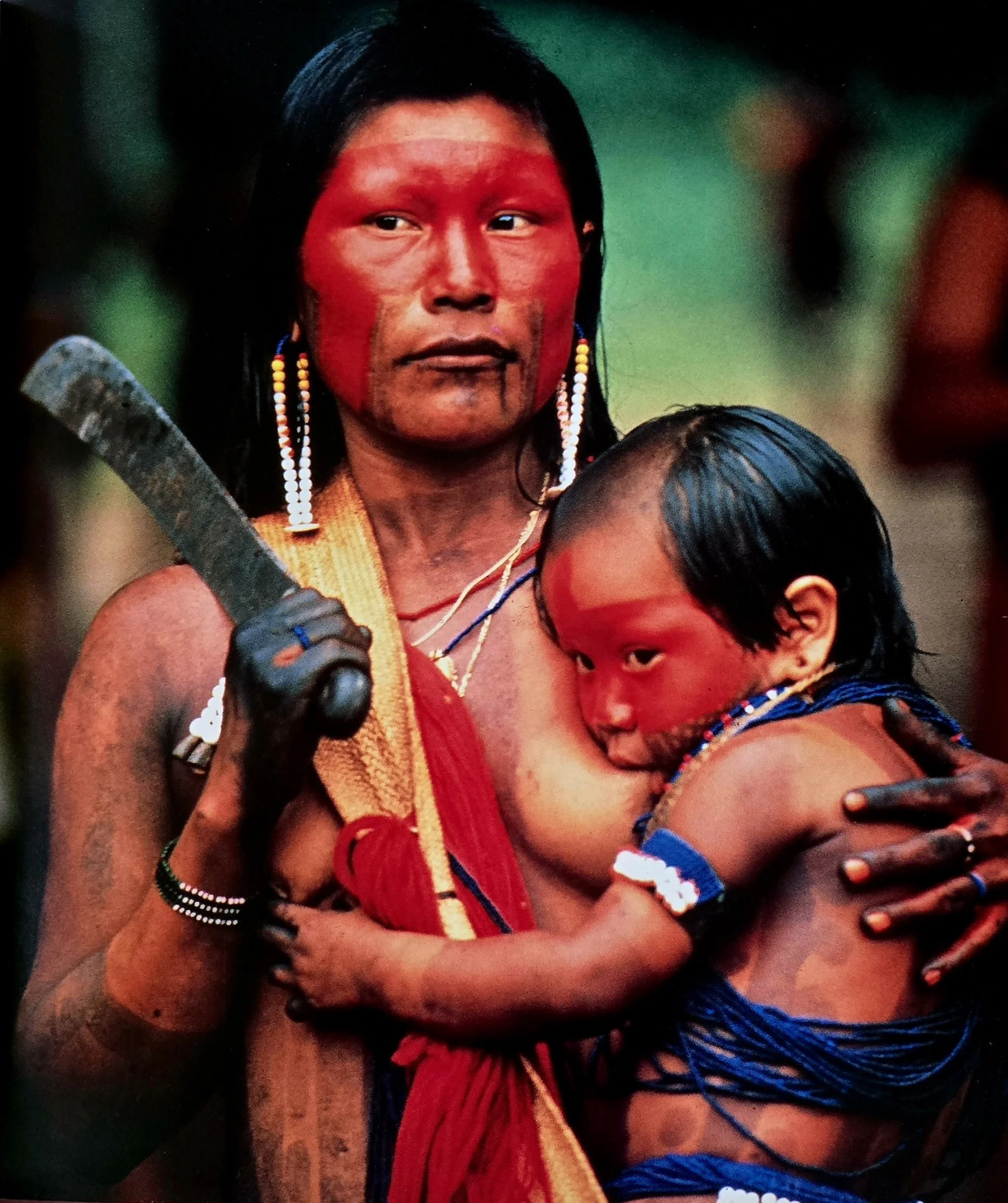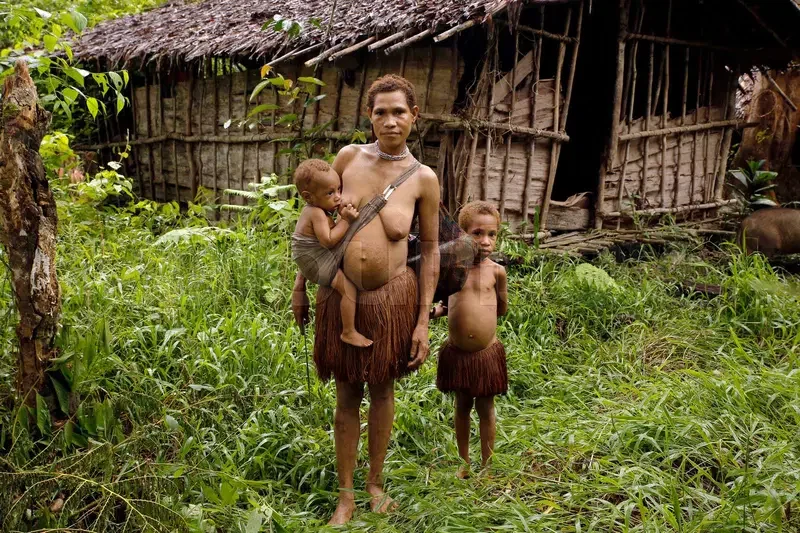Holding the Threads of the Past: Babywearing, Hunter-Gatherers, and the Fragility of Traditional Ways
For most of human history, we lived as hunter-gatherers: small, mobile bands moving lightly across forests, plains, deserts, and coasts. In these worlds, babies were never left behind. They were carried close, wrapped against a mother’s back, nestled into the crook of an elder’s hip, or cradled in a sibling’s arms.
Our survival as a species depended on deep cooperation — a communal dance where everyone played a role in nurturing and protecting the youngest. Babies were part of every step, every gathering of roots and berries, every trek to water, every quiet watch under star-filled skies. They learned the language of the land through touch, warmth, and the soft hum of family voices.
Even today, a few remaining hunter-gatherer and semi-nomadic peoples continue to live in ways that echo this ancient rhythm. Among the Hadza of Tanzania and the San people of southern Africa, babies are still carried as they always have been — close enough to feel every breath, hear every story, and sense every footfall on the earth. Among the forest-dwelling BaYaka and Mbendjele of the Congo Basin, babies sway in bark cloth wraps or simple carrying straps, learning the pulse of the rainforest from their first days.
In this striking, contemporary photograph, a San (also known as Bushmen) mother from southern Africa stands in the golden light of the savanna, carrying her baby close against her chest. The baby peeks out quietly from a simple, expertly tied cloth wrap made of natural material, safely enveloped against the mother’s body and able to nurse or rest whenever needed.
The mother’s steady gaze into the distance and her strong, upright posture reflect both resilience and deep connection to her environment — a landscape her community has called home for thousands of years. The carrying method, using a soft cloth or hide wrapped over one shoulder and tied at the hip or back, is a timeless practice among San women, allowing for close physical contact and ongoing communication between mother and child.
In San communities, babywearing is integral not only for practical reasons — allowing mothers to gather food, walk long distances, and work — but also for nurturing an intimate bond. Constant closeness fosters secure attachment and ensures the baby is included in daily community life from the very beginning.
This image beautifully captures the quiet strength, tenderness, and enduring wisdom of Indigenous parenting practices — a living reminder that the instinct to keep our little ones close transcends time, place, and culture.
But these ways of life are disappearing. The pressures of deforestation, mining, land encroachment, tourism, and aggressive development push these communities into ever-smaller corners of the world. Forced resettlements and loss of hunting grounds break apart the social threads that hold these societies together. Children are drawn away from the forest and the rhythms of ancestral life, pulled instead toward the isolating and often harsh realities of modern existence.
Among the uncontacted and voluntarily isolated peoples — such as those on North Sentinel Island or in the deep Amazon — the last threads of truly independent hunter-gatherer life hang by a fragile, threatened line. These communities resist outside contact fiercely, protecting not only their land but a worldview where babies are still carried in arms, where knowledge is passed by breath and skin, not screens or textbooks.
A mother from the Kayapo people of Brazil stands with quiet strength, her body adorned in bold red body paint made from urucum (annatto), a traditional plant dye. Her child is nestled closely against her chest, breastfeeding with ease and familiarity, their skin also painted in matching ceremonial designs. The child is partially wrapped in blue cord and beads, symbols of cultural identity and protection. In the mother’s hand rests a large machete—an emblem of her role as both nurturer and protector within her community. Her earrings and bracelets, vibrant with beads, reflect generations of skilled craft and cultural continuity. Here, caregiving and readiness walk side by side.
In other parts of the world, small fragments of tribal groups struggle to maintain their traditions in remote valleys, desert edges, or high mountain passes. The Surma in Ethiopia, the Penan in Borneo, and the Aché in Paraguay still hold echoes of these older ways. Yet even here, roads creep closer, missionaries arrive, and global hunger for resources and cheap land gnaws at their existence.
A mother from the Korowai people of Papua, Indonesia stands barefoot in the lush forest outside a traditional raised bark-and-thatch dwelling. She wears a grass skirt and carries her younger child on her hip, supported by a handmade bark-fiber strap that wraps over one shoulder. Beside her stands her older child, mirroring her attire and presence. Both children are bare-chested, as is traditional in this equatorial rainforest region. The mother’s steady gaze meets the camera, while her youngest nurses at her breast — a quiet, unbroken connection amid the surrounding greenery. Their clothing, home, and way of carrying reflect a lifestyle in deep rhythm with the forest that sustains them.
When we lose these lifeways, we lose more than just unique languages or beautiful crafts — we lose living proof of a different way to be human. A way that places community above the individual, that centers cooperation over competition, and that holds babies as the heart of the collective, carried close and never left behind.
Babywearing in these societies is not just a parenting choice; it is a symbol of a worldview that honors interdependence, gentleness, and the shared responsibility for life. It reminds us that, for most of human history, our children learned from our bodies and our breath, woven into the daily song of family and land.
As we witness these cultures vanish or fracture under the weight of the modern world, we are called to reflect: What do we carry forward? What do we protect? And how can we honor the wisdom embodied in these ancient ways, even as we move through an ever-changing present?
In every wrap, every bark cloth sling, every softly knotted shawl, there is a quiet message — a whisper from our collective past:
Carry your babies close. Carry each other. Protect the threads of connection. And remember, always, that we were made to belong to one another.
A note of gratitude and respect
We respectfully acknowledge and honor the individuals and communities depicted in historical images throughout this series. Many of these photographs were taken in times and contexts where informed consent as we understand it today was not sought or given, and some may have been created through coercion or exploitation.
We share these images with the deepest gratitude, not to romanticize or objectify, but to recognize and celebrate the strength, resilience, and wisdom of these cultural practices. We hold these ancestors and knowledge holders in our hearts and aim to represent their traditions with integrity, humility, and care.
We commit to continuing to learn, listen, and uplift the voices of contemporary community members and descendants, and we welcome guidance on the respectful sharing of these images.
Further Reading:



